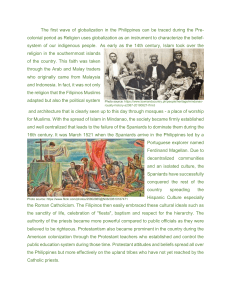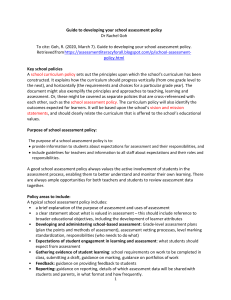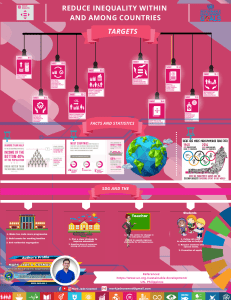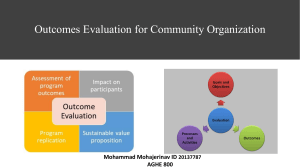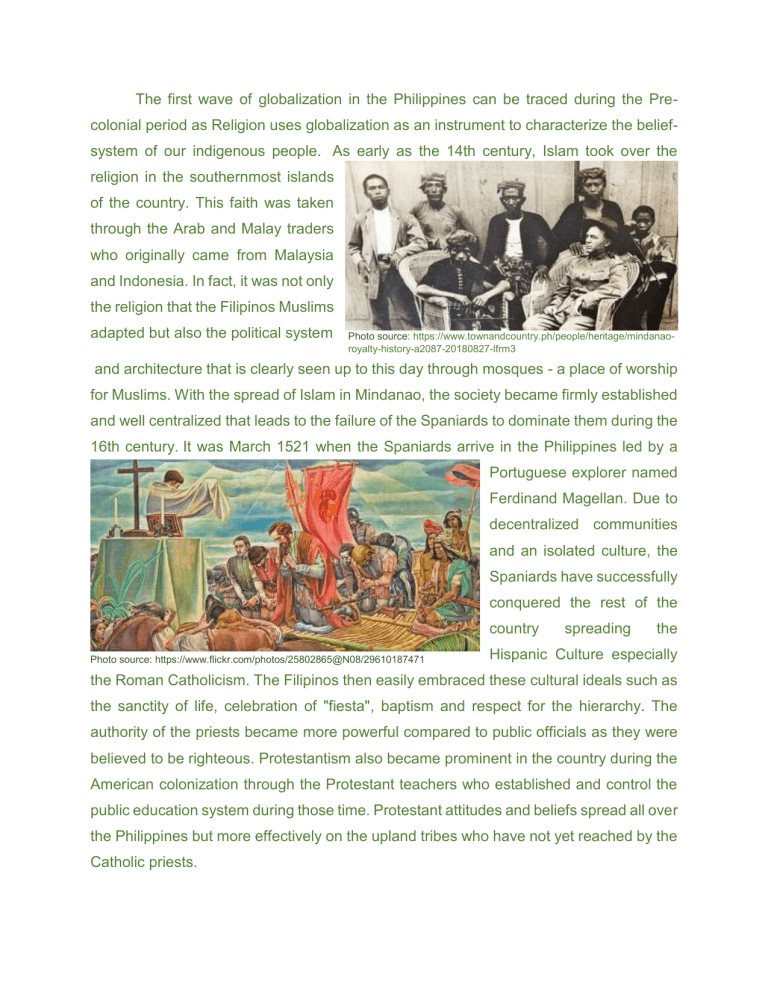
The first wave of globalization in the Philippines can be traced during the Precolonial period as Religion uses globalization as an instrument to characterize the beliefsystem of our indigenous people. As early as the 14th century, Islam took over the religion in the southernmost islands of the country. This faith was taken through the Arab and Malay traders who originally came from Malaysia and Indonesia. In fact, it was not only the religion that the Filipinos Muslims adapted but also the political system Photo source: https://www.townandcountry.ph/people/heritage/mindanaoroyalty-history-a2087-20180827-lfrm3 and architecture that is clearly seen up to this day through mosques - a place of worship for Muslims. With the spread of Islam in Mindanao, the society became firmly established and well centralized that leads to the failure of the Spaniards to dominate them during the 16th century. It was March 1521 when the Spaniards arrive in the Philippines led by a Portuguese explorer named Ferdinand Magellan. Due to decentralized communities and an isolated culture, the Spaniards have successfully conquered the rest of the country Photo source: https://www.flickr.com/photos/25802865@N08/29610187471 spreading the Hispanic Culture especially the Roman Catholicism. The Filipinos then easily embraced these cultural ideals such as the sanctity of life, celebration of "fiesta", baptism and respect for the hierarchy. The authority of the priests became more powerful compared to public officials as they were believed to be righteous. Protestantism also became prominent in the country during the American colonization through the Protestant teachers who established and control the public education system during those time. Protestant attitudes and beliefs spread all over the Philippines but more effectively on the upland tribes who have not yet reached by the Catholic priests. As of now, religions continuously shaped the culture and belief of the society leading to some implications such as Religion Pluralism and Religion Syncretism. Religion Pluralism is defined by Berger (2016) as the peaceful coexistence of different Religions in the Philippines religions within the same society. He also stated that this Pluralism influences religious community and every believer to find the core-essence of their faith and set aside those that are not Evangelical Iglesia Ni Cristo Aglipayan Other Christian Muslim Other Religions Unspecified None essential in order to understand faith deeper with other believers. On the other hand, Beyer (2018) defines Religion Syncretism as a formation of a religion from two or more sources of religious ideals. An example of this are the Igorot Christians in Cordillera and the Folk Catholicism in Malitbog, Central Panay. The Philippines, being the only Christian nation in Asia, now comprises of 80.9% Roman Catholic, 2.8% Evangelical, 2.3% Iglesia ni Cristo, 2% Aglipyan, 4.5% Other Christian religions, Islam 5%, 1.8% other religions 0.6% are unspecified and 0.1% have none. Despite of having religion as an instrument in building the morals of the people and creating a stable and charitable community, Religion are sometimes linked with societal conflicts such as politics and threat of terrorism. This can be seen on the case of a recent terrorist attack of a local terrorist group known as the Maute Group. The attack was said to be done to pledge allegiance to the Islamic State of Iraq and Syria or most commonly known as ISIS. This militant group is recognized with killing people and carrying out public executions and other scandalous acts. Their primary goal is to implement the Sharia Law, Photo source: https://news.abs-cbn.com/news/multimedia/photo/04/03 /18/ an-aerial-view-of-marawi a law rooted from the 8th century Islam in order to create a society that reflects their regions’ ancient past. The Maute Group attack lead to the destruction of homes, infrastructures and lost of lives. Another case is the so called “Unity Vote” of the Iglesia ni Cristo members during the senatorial vote last May 13, 2019 wherein the INC administration through its Executive Bro., Eduardo Manalo releases the decision on who to vote from people running for national positions down to local and barangay positions. The said indorsement became a very controversial issue criticizing the religious sector from controlling its devotees and by abusing their influence and power. However, some of the INC member speak up saying that it was their way of showing unity Photo source: https://www.rappler.com/move-ph/28884-iglesia-cristopicks-candidates as what said on their biblical doctrine. Religion plays a big part of Globalization even up to now as it still thrives to flourish and influence people from marginalized areas. In the modern days, Religion makes use of the technology and trends to make their connection between members easily available. Various religious sectors are also now open to changes and ideas as the community continuously evolves for them to remain as the idea of “home” on most people. As stated by Golebiewski (2014), the relationship of Globalization and Religion always came up with boundless possibilities and furthering challenges. REFERENCE: Berger, Peter L. (2016). The good of religous pluralism. Retrieved from: https://www.firstthings.com/article/2016/04/the-good-of-religious-pluralism Beyer, Catherine. (2018). Syncretism – what is syncretism? Retrieved from: https://www.learnreligions.com/what-is-syncretism-p2-95858 Bueza, Michael. (2017). Timeline: the ‘liberation’ of Marawi. Retrieved from: https://www.google.com/amp/s/amp.rappler.com/newsbreak/iq/185978-timelineliberation-marawi-city CNN Library, (2019). ISIS Fast Facts. Retrieved from: ttps://www.google.com/amp/s /amp.cnn.com/cnn/2014/08/08/world/isis-fast-facts/index.hthml Cultural Atlas. (n.d.). Filipino culture: religion. Retrieved from: https://culturalatlas.sbs.com.au/filipino-culture/filipino-culture-religion Golebiewski, Daniel. (2014). Religion and globalization: new possibilities, furthering challenges. Retrieved from: https://www.e-ir.info/2014/07/16/religion-and- globalization-new-possibilities-furthering-challenges/ Koerner, Brendan. (2005). How islam got to the Philippines. Retrieved from: https://www.google.com/amp/s/slate.com/news-and-politics/2005/01/how-islamgot-to-the-philippines.amp Lauren, Michael & Pack, Sam. (2016). Religion syncretism in the philippines. Retrieved from: https://www.google.com/url?sa=t&source=web&rct=j&url=http://biology.ken yon.edu/HHMI/posters_2016/michaell.pdf&ved=2ahUKEwj2v-CJwdbjAhUGat4K HW3yChUQFjAAegQIARAB&usg=AOvVaw1g3X25L0D2UA2_THBVPmsA&cshi d=1564279276078 Miller, Jack. (2019). Religion in the philippines. Retrieved from: https://asiasociety.org/education/religion-philippines?fbclid=IwAR2Z7zpHDr80eh bXKvxeCjajpAj9zPRSagSkj8oSuGCWsUgvyKYo0SnqWkU Nation Master. (n.d.). Philippine religion Stats. Retrieved https://www.nationmaster.com/country-info/profiles/Philippines/Religion from: Pena Cruz, Romy. (2019). Iglesia ni Cristo decides on unity vote for 2019 elections. Retrieved from: https://www.pep.ph/news/143155/iglesia-ni-cristo-decides-on- unity-vote-for-2019-elections-a1280-20190509 Russell, Susan. (n.d). Christianity in the philippines. http://www.seasite.niu.edu/crossroads/russell/christianity.htm PLAGIARIM CHECKER: Retrieved from:


